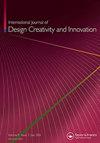“固定”和“支点”:在设计和创业中平衡持久性与灵活性
IF 2.5
Q4 ENGINEERING, MANUFACTURING
International Journal of Design Creativity and Innovation
Pub Date : 2018-04-03
DOI:10.1080/21650349.2017.1362359
引用次数: 51
摘要
抽象的“设计固定”发生在对解决方案空间的探索无意中受到设计者对先前解决方案的知识的约束时。固定的研究在设计研究中已经确立,但很少有人讨论通过研究其他创造性实践中的相关现象可以学到什么。为了解决这个问题,我们对科技企业家和指导他们的顾问进行了一系列采访。访谈数据的分析依据了创造性固定、认知巩固和心理所有权的概念,以及创业转向、战略变革和商业模式创新的概念。研究表明,企业家必须积极平衡持久性和灵活性,这项任务受到以下因素的影响:(i)企业家对自己想法的承诺,(ii)他们发展的专业知识,(iii)他们寻求或接触的信息,(iv)他们可用的资源,以及(v)他们对产品或市场的取向。总之,这些发现可以应用于设计研究,作为研究固定时研究新主题的建议。它们还通过建议设计师(及其管理者)在确定改变设计方向的机会时应该反思什么,对设计实践有启示。本文章由计算机程序翻译,如有差异,请以英文原文为准。
‘Fixation’ and ‘the pivot’: balancing persistence with flexibility in design and entrepreneurship
Abstract ‘Design fixation’ occurs when exploration of the solution space is unintentionally constrained by designers’ knowledge of prior solutions. The study of fixation is well established in design research but there has been little discussion of what might be learned about fixation from studying related phenomena in other creative practices. To address this, a series of interviews were conducted with technology entrepreneurs and the advisors who guide them. Analysis of the interview data was informed by concepts of creative fixation, cognitive entrenchment and psychological ownership, but also concepts of entrepreneurial pivoting, strategic change and business model innovation. The study shows that entrepreneurs must actively balance persistence with flexibility, a task that is influenced by (i) the entrepreneurs’ commitment to their ideas, (ii) the expertise that they have developed, (iii) the information that they seek or are exposed to, (iv) the resources available to them, and (v) their orientation towards either the product or the market. Collectively, these findings can be applied to design research as proposals for new topics to study when investigating fixation. They also hold implications for design practice by suggesting what designers (and their managers) should reflect on when identifying opportunities to change design direction.
求助全文
通过发布文献求助,成功后即可免费获取论文全文。
去求助
来源期刊

International Journal of Design Creativity and Innovation
ENGINEERING, MANUFACTURING-
CiteScore
3.80
自引率
27.80%
发文量
15
期刊介绍:
The International Journal of Design Creativity and Innovation is an international publication that provides a forum for discussing the nature and potential of creativity and innovation in design from both theoretical and practical perspectives. Design creativity and innovation is truly an interdisciplinary academic research field that will interest and stimulate researchers of engineering design, industrial design, architecture, art, and similar areas. The journal aims to not only promote existing research disciplines but also pioneer a new one that lies in the intermediate area between the domains of systems engineering, information technology, computer science, social science, artificial intelligence, cognitive science, psychology, philosophy, linguistics, and related fields. The journal covers, but is not restricted to, the following topics: ·Theories on Design Creativity and Innovation ·Cognition of Design Creativity ·Innovative Process ·Inventive Process ·Analogical Reasoning for Design Creativity and Innovation ·Design Synthesis ·Method and Tools for Design Creativity and Innovation ·Representation of Design Creativity and Innovation ·Education for Design Creativity and Innovation ·Concept Generation and Inspiration.
 求助内容:
求助内容: 应助结果提醒方式:
应助结果提醒方式:


